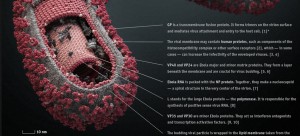Ebola is the latest viral hazard that is a threat to many aspects of life in the modern world; including sectors that exist on globalisation and international travel. This virus, currently, has no cure and thus is a bigger threat as more people die from exposure which warrants a more in-depth analysis on the organism’s anatomy, mutation possibilities, genetic composition, scenarios and its path through the human body as well as detection of this virus in-advance.
Ebola, by nature is an RNA virus whose active composition is made from RiboNucleic Acid, making the virus mutagenic; this virus already has a variety of strains.
- EBO-Z, Zaire strain
- EBO-S, Sudan strain/ “Sudan Virus.”
- EBO-B, Bundigugyo strain/”Bundigugyo Virus”
- EBO-CI, Ivory Coast strain
- EBO-R, Reston strain
The virus spreads by close contact and has 25-90% fatality chance with the following symptoms occurring as follows;
- Day 7-9, Headache, fatigue, fever, muscle and joint pain.
- Day 10, Sudden high fever, vomiting, blood pressure and passive behavior.
- Day 11, Bruising, brain damage nasal, anal, mouth and eye bleeding.
- Day 12, Loss of consciousness, seizures, internal bleeding and eventual death.
Ebola, by nature is also a hemorrhaging fever virus which suppresses the host’s immune system which has a burn rate of 12-20 days. Victims have no noticeable symptoms in the first week; this is the virus’ gestation state where the cells multiply. The virus, except for Reston strain is not airborne; thus is spread by physical contact or spread of bodily fluids by aerosol done by sweating, urinating and sexual transmission; warranting barrier nursing practices with strict patient isolation and rigorous disinfection along with effective management of the deceased.
So far, we covered what the virus is genetically and how it functions inside its host as well as its symptoms and their undetectable initiation. However, more attention is required to the possible measures to be taken to decrease the spread of the virus. As there is still no cure against Ebola, the most logical step is to slow and eventually control its spread; with education and control being the most important variables.
Looking back at the undetectable nature of the symptoms it is hard to detect it earlier and thus adding to the risk factor as the virus spreads on physical contact and will infect the unknowing bystanders. The first step should be discovering if a person is infected; this can be done by a controversial tactic of espionage which will monitor the person’s behavior which will, in-turn give physical health status. The first days of Ebola have headaches, joint, muscle pain and fatigue; symptoms which will produce bodily gestures such as hindered, slow movement, sudden jerking of moving limbs and rubbing of head due to migraines.
Another challenge is spotting these symptoms after tasks that involve manual labour/something that will cause muscle cramps and fatigue and thus will be harder to differentiate between normal and Ebola symptoms. However there is a possibility by which the differences can be spotted sooner than next day; normal muscle cramps are easier to control than Ebola cramps which will help spot the infected by seeing the jerky, hindered movement persist and occur more regularly.
Later on in the virus’ life cycle, symptoms of passive behavior, vomiting and high fever appear; something relatively easy to spot. Vomiting during Ebola is uncontrolled and happens constantly which means that distance should be kept to avoid contacting the virus. Such symptoms are easy to spot and thus should be reported to superiors who in-turn, should quarantine the person and initiate dis-infection measures across the vessel. Passive behavior is also easy to spot as the infected will have a unique manner of slow movement and emotionless responses and short attention span. Seeing such behavior should also be reported.
Finally, after reporting these symptoms to the vessel authority it is essential to establish a quarantine zone onboard. This zone can needs to have only a single entry/exit and means of lockdown to isolate patients and prevent infection from spreading. Quarantine zone should be guarded and controlled by barrier nursing techniques and security measures.
Overall, Ebola is a deadly virus which cannot be cured yet but can be controlled and prevented from spreading using simple techniques of quarantine creation and patient control. Symptoms are also relatively hard to detect but with more attention they can be seen and reported. Reporting is one of the most important measures that can be taken to control the disease.


